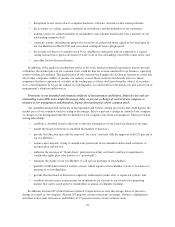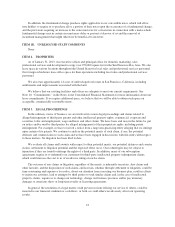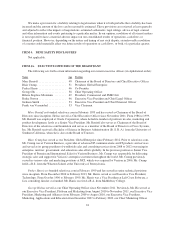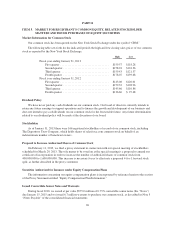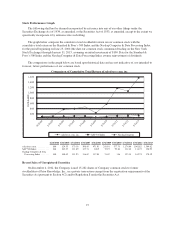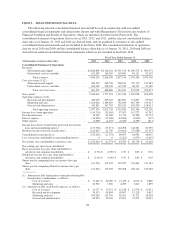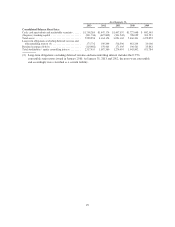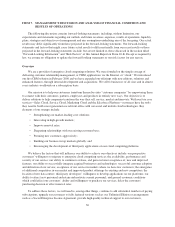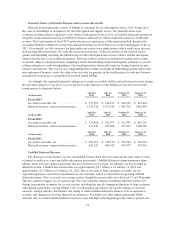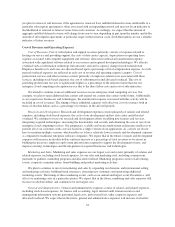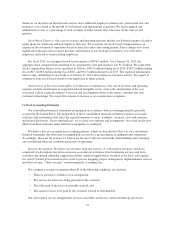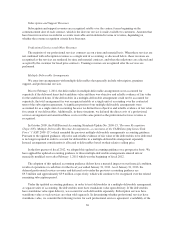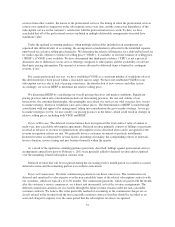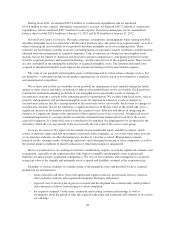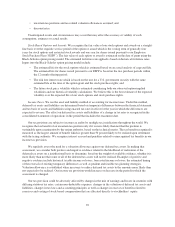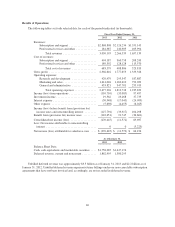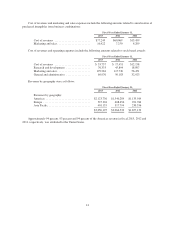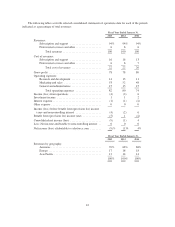Salesforce.com 2013 Annual Report Download - page 36
Download and view the complete annual report
Please find page 36 of the 2013 Salesforce.com annual report below. You can navigate through the pages in the report by either clicking on the pages listed below, or by using the keyword search tool below to find specific information within the annual report.Sources of Revenues
We derive our revenues from two sources: (1) subscription revenues, which are comprised of subscription
fees from customers accessing our enterprise cloud computing services and from customers purchasing
additional support beyond the standard support that is included in the basic subscription fees; and (2) related
professional services such as process mapping, project management, implementation services and other revenue.
“Other revenue” consists primarily of training fees. Subscription and support revenues accounted for
approximately 94 percent of our total revenues during fiscal 2013. Subscription revenues are driven primarily by
the number of paying subscribers, varying service types, the price of our service and service renewal rates. We
define a “customer” as a separate and distinct buying entity (e.g., a company, a distinct business unit of a large
corporation, a partnership, etc.) that has entered into a contract to access our enterprise cloud computing services.
We define a “subscription” as a unique user account purchased by a customer for use by its employees or other
customer-authorized users, and we refer to each such user as a “subscriber.” The number of paying subscriptions
at each of our customers ranges from one to hundreds of thousands. None of our customers accounted for more
than five percent of our revenues during fiscal 2013, 2012, or 2011.
Subscription and support revenues are recognized ratably over the contract terms beginning on the
commencement dates of each contract. The typical subscription and support term is 12 to 36 months, although
terms range from one to 60 months. Our subscription and support contracts are non-cancelable, though customers
typically have the right to terminate their contracts for cause if we materially fail to perform. We generally
invoice our customers in advance, in annual or quarterly installments, and typical payment terms provide that our
customers pay us within 30 days of invoice. Amounts that have been invoiced are recorded in accounts
receivable and in deferred revenue, or in revenue depending on whether the revenue recognition criteria have
been met. In general, we collect our billings in advance of the subscription service period.
Professional services and other revenues consist of fees associated with consulting and implementation
services and training. Our consulting and implementation engagements are typically billed on a time and
materials basis. We also offer a number of training classes on implementing, using and administering our service
that are billed on a per person, per class basis. Our typical professional services payment terms provide that our
customers pay us within 30 days of invoice.
In determining whether professional services can be accounted for separately from subscription and support
revenues, we consider a number of factors, which are described in “Critical Accounting Policies and Estimates—
Revenue Recognition” below. Prior to February 1, 2011, the deliverables in multiple-deliverable arrangements
were accounted for separately if the delivered items had standalone value and there was objective and reliable
evidence of fair value for the undelivered items. If the deliverables in a multiple-deliverable arrangement could
not be accounted for separately, the total arrangement fee was recognized ratably as a single unit of accounting
over the contracted term of the subscription agreement. A significant portion of our multiple-deliverable
arrangements were accounted for as a single unit of accounting because we did not have objective and reliable
evidence of fair value for certain of our deliverables. Additionally, in these situations, we deferred the direct
costs of a related professional service arrangement and amortized those costs over the same period as the
professional services revenue was recognized.
In October 2009, the Financial Accounting Standards Board (“FASB”) issued Accounting Standards Update
No. 2009-13, “Revenue Recognition (Topic 605), Multiple-Deliverable Revenue Arrangements—a consensus of
the FASB Emerging Issues Task Force” (“ASU 2009-13”) which amended the previous multiple-deliverable
arrangements accounting guidance. Pursuant to the new guidance, objective and reliable evidence of fair value of
the deliverables to be delivered is no longer required in order to account for deliverables in a multiple-deliverable
arrangement separately. Instead, arrangement consideration is allocated to deliverables based on their relative
selling price. In the first quarter of fiscal 2012, we adopted this new accounting guidance on a prospective basis.
We applied the new accounting guidance to those multiple-deliverable arrangements entered into or materially
modified on or after February 1, 2011 which was the beginning of our fiscal 2012.
32


